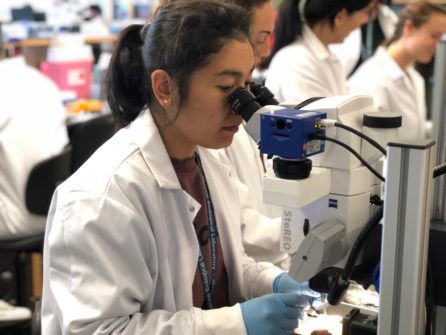Munisha Mumingjiang is Getting Back to Basics to Understand the Placenta
NewsFor NYSCF – Druckenmiller Postdoctoral Fellow Munisha Mumingjiang, MD, PhD, of Cornell University, a planned career as an OB/GYN sparked a drive to understand a notoriously understudied topic: the placenta.
Apply for the 2023 awards here
The placenta provides essential support to a growing fetus, and could be at the root of many common issues such as pregnancy loss and preeclampsia. It has traditionally been a challenge to study (it’s only really accessible once a baby is born), but stem cells are giving her the tools to get to the bottom of her burning questions.
Learn more about what inspired Munisha to pursue science, her research, and why she thinks STEM education is critical for reaching cures.
What made you decide to become a scientist?
I’ve always been interested in science. My dad is a physics professor, so I grew up thinking science was really cool, and then I went to medical school in China. The system is a little different there: you get in directly out of high school, and you spend the first two years in your basic biology courses before getting into clinical medicine. I really enjoyed those basic science classes, and once I got into the clinic, I found myself often wanting to go back to basics and understand the mechanisms actually causing a disease so we could figure out how to treat it. That’s why I went back to get my PhD.
What made you interested in stem cells?
My biggest interest was in developmental biology, and when you think about development, it all comes from a single cell, which is a stem cell. I was always curious about how a cell becomes what it wants to be within an embryo. In my work, we study how the placenta develops, and the best model to study this is stem cells, since they also let us really examine the genomes of cells and see how they develop.
What drew you to study reproductive biology?
There are a couple of reasons. One of them is my medical background as an OB/GYN, and the disease mechanisms that lead to pregnancy complications are not fully understood, with the placenta being a big factor. And it’s hard to study the placenta: you can’t just take it out while someone is pregnant, so by the time we can examine it, it’s too late. But, if we understand the basic biology [of placental development], we might be able to find out what’s happening in disease conditions.

I also think that it’s interesting that something that seems as transient as the placenta, which you don’t really need once the baby is born, but it turns out that whatever is happening in the placenta can have lifelong effects. If you have developmental defects, preeclampsia, or a growth restriction, those babies that are successfully born have increased risk of cardiovascular or neurological disorders later in life.
How does your lab use stem cells to look at preeclampsia and pregnancy loss?
We’ve selected a whole bunch of genes that may be involved in maintaining genomic integrity, which could be important for how the placenta develops, but is very understudied. So with stem cells, we can look at genes involved in placental development to see which are most important.
We can also one day hopefully screen cells to identify certain genetic features that may contribute to increased risk of preeclampsia. We could perhaps develop a diagnostic tool for pregnant people to predict what will happen to their placenta.
What do you hope to achieve in your career in research?
This is an area of research no one has ever explored before. If our projects are successful, and we discover a lot of genes that may be involved in placental development, then that opens up a lot more scientific questions and hopefully lead to new diagnostic and treatment options.
You do a lot of volunteering and science education. Why is this so important to you?
I think part of the reason is because I really benefited from science education, and it’s why I’m able to be here. Especially coming from a minority background, I understand the impact of STEM education in those communities.
Also being the daughter of two college professors, I always like to inspire and encourage students, especially those from underrepresented backgrounds to excel and hopefully become even better than me at what I do!
What advice would you give to young people who are interested in pursuing STEM?
This is going to sound cliche, but I would say believe in yourself, and hard work always pays off. Especially as an underrepresented person in STEM, I’ve had a lot of imposter syndrome and doubted myself many times, but as long as you persevere, you’ll get where you want to go.
How have you seen the importance of diversity, equity, inclusion, and belonging (DEIB) in STEM throughout your career?
I think it’s really important to have people from the same background as you to look up to as an example of what’s possible. That representation is really important for minority groups, because if you know other people are achieving, then it builds your confidence that you can do the same or even better.
What is most exciting to you about receiving this award and joining the NYSCF Innovator community?
What’s most exciting to me is joining NYSCF’s really diverse community. NYSCF brings scientists from all areas together to enhance communication between people from different backgrounds, and I think that makes a huge difference for research. You can learn new techniques from people, get new ideas, and think about approaching questions from new ways. All of that not only enriches your own knowledge, but enhances scientific discovery.